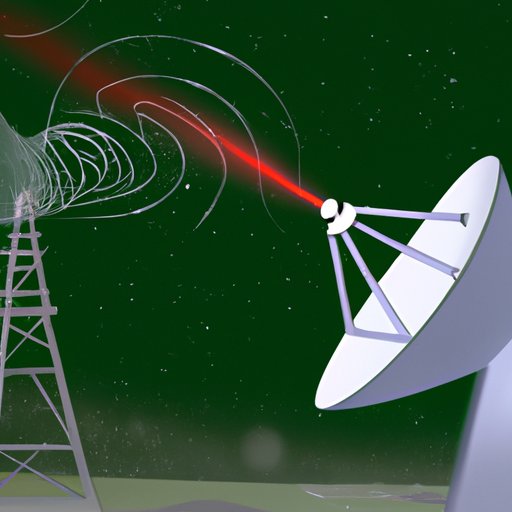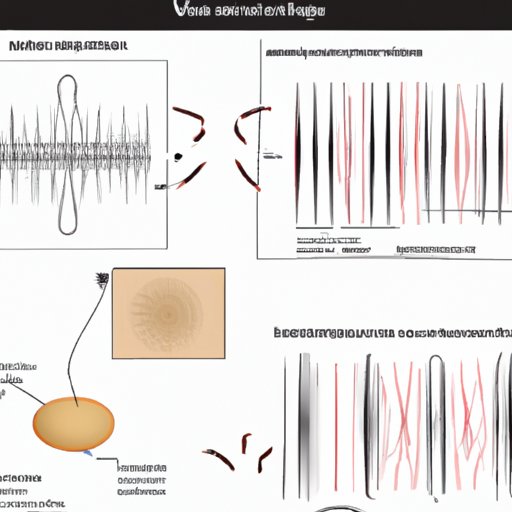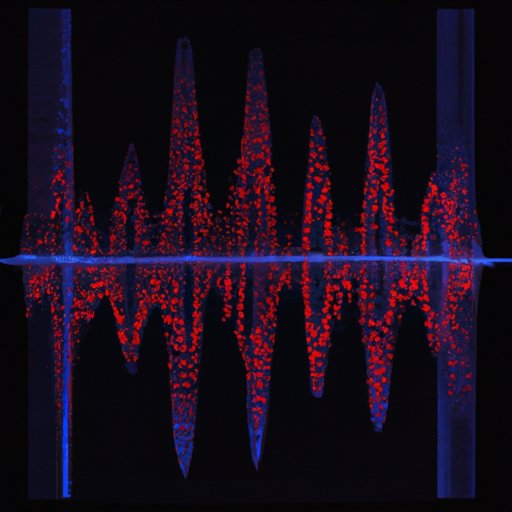Introduction
Radio waves are a type of electromagnetic radiation that can be used to transmit information from one location to another. They are essential for many modern technologies, including television, mobile phones, and wireless networks. But how do these invisible signals travel through the vastness of space? In this article, we explore the science behind how radio waves propagate through the universe.

Exploring the Physics of Radio Waves in Outer Space
To understand how radio waves move through space, it is important to first understand electromagnetic fields. Electromagnetic fields are composed of electric and magnetic fields that are created when charged particles move. These fields can interact with each other and create waves, which propagate outward in all directions.
When a radio wave propagates through space, it is made up of wave particles called photons. These particles have both an electric and magnetic component, which allows them to interact with other electromagnetic fields. As the wave moves through space, it can be affected by various phenomena, such as reflection, refraction, and diffraction.
Reflection occurs when a wave encounters a surface that is not perfectly smooth or transparent. In this case, some of the energy is reflected back towards its source, while the rest continues to propagate in the same direction. Refraction occurs when a wave passes through a medium that has a different density than the surrounding environment. This causes the wave to bend and change its direction of propagation. Diffraction is the process by which waves bend around obstacles, allowing them to reach areas that would otherwise be blocked.
How Do Radio Signals Propagate Through the Universe?
Radio signals propagate through the universe in a variety of ways. The most common is direct line-of-sight propagation, which occurs when the signal is sent directly from the transmitter to the receiver without any obstacles in between. This is the most efficient method of transmission, as it requires minimal power and provides the strongest possible signal.
Signal loss and attenuation can occur when a signal is transmitted over long distances. Signal loss occurs when the signal is weakened due to absorption, scattering, or other forms of interference. Attenuation is the gradual weakening of a signal over distance. Both of these phenomena can reduce the strength of the signal and make it more difficult for the receiver to decode the information.
The properties of amplitude and frequency also play a role in radio wave propagation. Amplitude is the amount of energy contained in a given wave, while frequency is the number of times the wave oscillates per second. Higher frequencies tend to travel farther than lower frequencies, but they also require more power to transmit. Similarly, higher amplitudes will travel farther than lower amplitudes, but they also require more power.
Interference can also affect radio wave propagation. Interference can be caused by other sources of electromagnetic radiation, such as satellites, power lines, and cell towers. It can also be caused by weather conditions, such as thunderstorms, which can disrupt the signal and cause it to be weaker when it reaches its destination.

Examining the Role of Electromagnetic Fields in Radio Wave Transmission
Electromagnetic fields play an important role in radio wave transmission. Magnetic fields are generated by moving electric charges and can interact with other magnetic fields. Electric fields are created by static electric charges and can also interact with other electric fields. When two electromagnetic fields interact, they can create a wave that propagates through space.
Polarization is another important factor in radio wave propagation. Polarization refers to the orientation of the electric field. A vertically polarized wave will propagate differently than a horizontally polarized wave. This can affect the strength of the signal, as well as its ability to penetrate certain materials.
Electric and magnetic fields can also affect radio wave propagation. Electric fields can cause a signal to be refracted, while magnetic fields can cause a signal to be reflected. Additionally, electric and magnetic fields can interact with each other to produce a wave that can travel through space.
Analyzing the Impact of Distance on Radio Wave Transmission
Distance is another important factor in radio wave transmission. The further away the receiver is from the transmitter, the weaker the signal will be. This is because the signal is weakened as it passes through the atmosphere and is absorbed by various materials. Additionally, the signal is scattered and diffracted as it travels, which further reduces its strength.
Atmospheric conditions can also affect radio wave propagation. Humidity, temperature, and wind can all cause the signal to be weakened or distorted. For long-distance transmissions, it is important to choose a frequency that can penetrate the atmosphere and reach the receiver without being significantly weakened.
Finally, it is important to consider the optimal frequency for long-distance radio wave transmissions. Lower frequencies tend to travel farther than higher frequencies, but they also require more power to transmit. Higher frequencies can be more easily blocked by obstacles, but they require less power. The best frequency for a given situation will depend on the environment and the distance between the transmitter and the receiver.
Conclusion
In conclusion, radio waves are an essential form of communication in today’s world. They can be used to transmit information from one location to another, but understanding how they propagate through space is essential for successful transmission. This article has explored the physics of radio waves in outer space, discussed their propagation, and analyzed the impact of distance on their transmission. It has also explored the role of electromagnetic fields and described the effects of signal loss and attenuation.
By understanding the science behind radio wave propagation, engineers and scientists can design better communication systems and optimize transmission efficiency. This knowledge can also be used to improve existing systems and help ensure reliable communication over long distances.
Summary of Key Points
This article has explored how radio waves travel through space. It has examined the physics of radio waves in outer space, discussed their propagation, and analyzed the impact of distance on their transmission. It has also looked at the role of electromagnetic fields and described the effects of signal loss and attenuation.
Recommendations for Further Research
Further research is needed to better understand how radio waves propagate through the universe. This could include exploring the effects of atmospheric conditions on radio wave transmission, investigating the optimal frequency for long-distance transmissions, and examining the role of polarization in signal propagation.
(Note: Is this article not meeting your expectations? Do you have knowledge or insights to share? Unlock new opportunities and expand your reach by joining our authors team. Click Registration to join us and share your expertise with our readers.)
